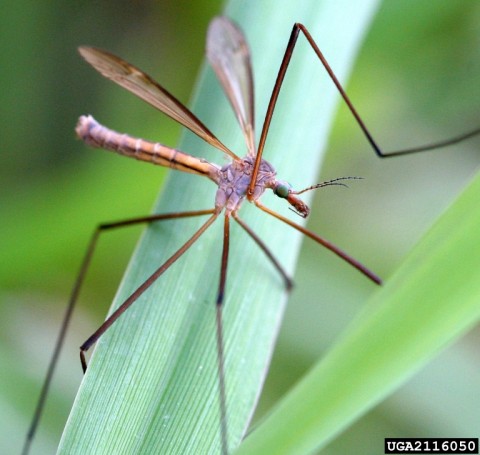
Adult crane fly. Photo: David Cappaert, Bugwood.org.
Adult crane flies emerge from the soil beneath lawns and other grassy areas in late summer and fall. They have very long legs and look like large mosquitoes. They may drive you crazy, but they are harmless. They don’t bite or sting.
Contrary to what chemical companies may tell you, autumn is not the time to worry about or treat for this insect. You cannot control crane flies by using insecticides when the adults are flying. They don’t stay still long enough. Female crane flies mate and lay eggs in grass within 24 hours of emerging.
Eggs hatch into small, brown larvae that looks like worms. They feed on the roots and crowns of grass plants in fall and spring; they are dormant in winter.
Crane fly populations often decline over the winter, perhaps by as much as 50%. Many birds, including starlings and robins, love to eat the grubs. Ground beetles also feed on crane fly larvae. Cold and disease reduce populations as well.
What you can do
The best crane fly control is to improve lawn health through proper fertilization, mowing, watering, aeration and other care. A healthy, vigorous, well-maintained lawn will easily recover from crane fly damage, even when the population is high.
We are currently doing fall aeration and fertilization services. Call us if you would like us to visit your property.
Crane flies thrive in wet soils, so drying out the soil will help reduce their numbers. Water your lawn deeply and infrequently. Provide better drainage for areas that tend to stay soggy.
The best time to check for crane flies is early spring. We will monitor your lawn for crane flies in February and March.
Not all crane flies are pests. There are 12-14 native crane flies that are beneficial in streams and forests. Only the European crane fly and common crane fly, both imported species, cause any problems. And even they are seldom a problem. A survey of almost 200 lawns in Whatcom County found that none had enough crane flies to require any pest controls.
Reference: Crane Flies, UC Pest Management Guidelines.
